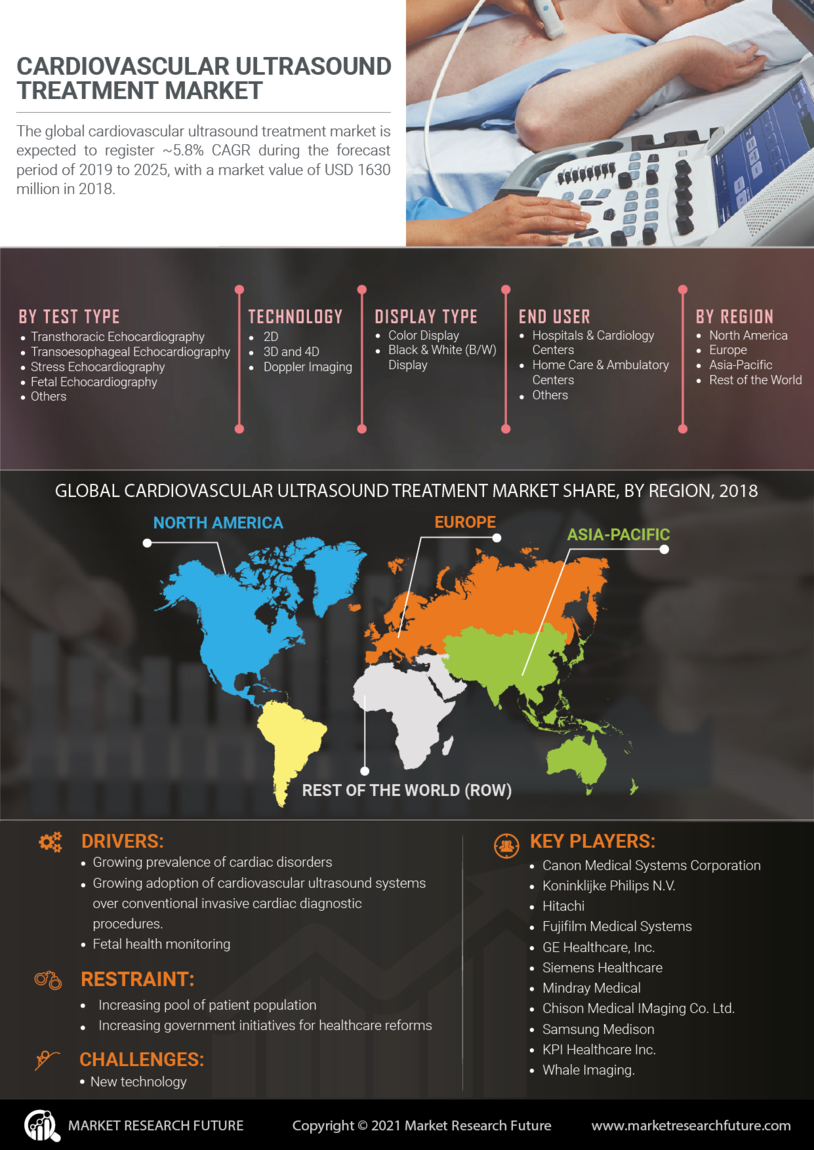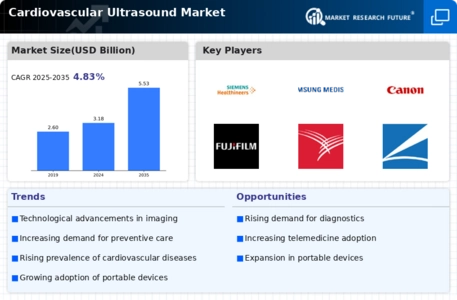Aging Population
The demographic shift towards an aging population is a critical factor influencing the Global Cardiovascular Ultrasound Market Industry. As individuals age, the risk of developing cardiovascular diseases increases significantly. The World Health Organization indicates that by 2030, the global population aged 60 years and older will reach 1.4 billion, necessitating enhanced cardiovascular monitoring and diagnostic services. This demographic trend compels healthcare providers to invest in advanced ultrasound technologies to cater to the needs of older patients, thereby propelling market expansion. The demand for non-invasive and efficient diagnostic methods is likely to rise in tandem with this aging demographic.
Market Growth Projections
The Global Cardiovascular Ultrasound Market Industry is projected to witness substantial growth, with estimates indicating an increase from 3.18 USD Billion in 2024 to 5.53 USD Billion by 2035. This growth trajectory suggests a compound annual growth rate of 5.16% from 2025 to 2035. Such projections reflect the increasing adoption of advanced ultrasound technologies, driven by factors such as rising cardiovascular disease prevalence, technological innovations, and government support for healthcare initiatives. The market's expansion is indicative of a broader trend towards enhanced cardiovascular care and the integration of advanced diagnostic tools in clinical practice.
Technological Advancements
The Global Cardiovascular Ultrasound Market Industry is experiencing rapid technological advancements, which enhance diagnostic capabilities and improve patient outcomes. Innovations such as 3D and 4D imaging techniques provide more detailed visualizations of cardiac structures, allowing for better assessment of heart conditions. Furthermore, the integration of artificial intelligence in ultrasound devices aids in automating image analysis, potentially reducing the time required for diagnosis. As a result, the market is projected to grow from 3.18 USD Billion in 2024 to 5.53 USD Billion by 2035, reflecting a compound annual growth rate of 5.16% from 2025 to 2035.
Government Initiatives and Funding
Government initiatives aimed at improving healthcare infrastructure and funding for cardiovascular health programs are pivotal in driving the Global Cardiovascular Ultrasound Market Industry. Many countries are implementing policies to enhance access to diagnostic imaging technologies, including ultrasound. For instance, public health campaigns focused on cardiovascular health awareness encourage early detection and treatment, leading to increased demand for ultrasound services. Additionally, funding for research and development in ultrasound technology fosters innovation, further supporting market growth. Such initiatives not only improve patient outcomes but also stimulate the adoption of advanced ultrasound systems in clinical settings.
Rising Demand for Point-of-Care Testing
The growing preference for point-of-care testing is reshaping the Global Cardiovascular Ultrasound Market Industry. Healthcare providers are increasingly adopting portable ultrasound devices that facilitate immediate diagnosis at the patient's bedside or in remote locations. This trend is particularly beneficial in emergency settings where timely intervention is crucial. The convenience and efficiency of point-of-care ultrasound systems enhance patient care and streamline workflow in clinical environments. As the demand for rapid diagnostic solutions continues to rise, manufacturers are likely to focus on developing user-friendly, portable ultrasound devices that cater to this emerging market need.
Increasing Prevalence of Cardiovascular Diseases
The rising incidence of cardiovascular diseases globally is a significant driver for the Global Cardiovascular Ultrasound Market Industry. Factors such as sedentary lifestyles, unhealthy diets, and increasing stress levels contribute to the growing number of patients requiring cardiovascular assessments. According to health statistics, cardiovascular diseases remain the leading cause of mortality worldwide, prompting healthcare systems to adopt advanced diagnostic tools like ultrasound. This trend underscores the necessity for effective screening and monitoring solutions, thereby driving market growth as healthcare providers seek to implement more comprehensive cardiovascular care.






















Leave a Comment